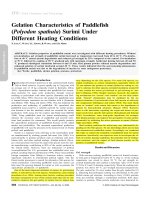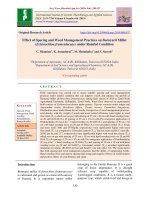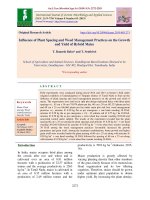Economic evaluation of rice-maize-green manure cropping system under different tillage and weed management practices in conservation agriculture
Bạn đang xem bản rút gọn của tài liệu. Xem và tải ngay bản đầy đủ của tài liệu tại đây (180.39 KB, 6 trang )
Int.J.Curr.Microbiol.App.Sci (2017) 6(3): 2363-2368
International Journal of Current Microbiology and Applied Sciences
ISSN: 2319-7706 Volume 6 Number 3 (2017) pp. 2363-2368
Journal homepage:
Original Research Article
/>
Economic Evaluation of Rice-Maize-Green Manure Cropping
System under Different Tillage and Weed Management Practices in
Conservation Agriculture
P. Leela Rani* and M. Yakadri
AICRP on Weed Management, College of Agriculture, Rendranagar, Professor Jayashankar
Telangana State Agricultural University, Hyderabad-500030, India
*Corresponding author
ABSTRACT
Keywords
CT (conventional
tillage), ZT (zero
tillage), System
productivity, Ricemaize-green
manure.
Article Info
Accepted:
24 February 2017
Available Online:
10 March 2017
A field investigation was carried out at college farm, Professor Jayashankar Telangana
State Agricultural University, Rajendranagar, Hyderabad during 2014-15 and 2015-16
with five tillage treatments CT (transplanted), CT (transplanted), CT (direct-seeded), ZT
(direct-seeded) and ZT+R (direct-seeded) for kharif rice fb CT, ZT, CT, ZT+R and ZT+R
treatments for rabi maize in sequence as main treatments and 3 weed management
practices (chemical method, IWM and weedy check) as subplots in split plot design
replicated thrice. Mean data of system productivity (rice-maize-green manure (dhaincha)
system) and economic analysis showed that, more system productivity, net returns and B C
ratio was obtained under conventional tillage (CT) kharif transplanted rice followed by
rabi maize under conventional tillage (12777 kg ha-1, Rs 1, 09,003 ha-1 and 2.53) and zero
tillage maize cultivation respectively (11455 kg ha -1, Rs 93,994 ha-1 and 2.39). Integrated
weed management practices recorded more system productivity, net returns and BC ratio
(12126 kg ha-1, Rs 1, 02, 625 ha-1 and 2.51) for kharif aerobic/transplanted rice (bispyribac
sodium 25 g/ha as early PoE at 15 DAT fb HW at 40 DAT) followed by rabi maize
(atrazine 1000 g ha-1+paraquat 600g ha-1 as PE fb HW at 40 DAS) in sequence
respectively.
Introduction
Post green revolution era has many challenges
like stagnated net sown area, reduction in per
capita land availability, climate change effects
and
deterioration
of
land
quality.
Conservation agriculture (CA) has emerged as
an effective strategy to enhance sustainable
agriculture worldwide. Rice-relay pulse crop
is an important crop sequence covering 0.3
million ha area in Andhra Pradesh. For the
past half decade, the greengram and
blackgram were subjected to yellow vein
mosaic and Cuscuta problem. In addition to
this, since 2003 onwards in Krishna delta of
Andhra Pradesh, due to late release of water,
transplanting of rice is delayed and ultimately
timely sowing of blackgram as relay crop is
not possible. Then, farmers are switching over
to non-traditional crop like maize in rice
fallows as an alternative to blackgram. Under
the emerging and potential crop sequence
(rice-maize) in coastal region of Andhra
Pradesh and Telangana state, conventional
tillage maize after kharif rice under heavy
textured soil needs 25-30% more energy for
2363
Int.J.Curr.Microbiol.App.Sci (2017) 6(3): 2363-2368
field preparation, which limits the farm
profitability and delays maize sowing leading
to
lower
productivity.
Conservation
agriculture (CA)-based technologies such as
zero, reduced tillage facilitates timely sowing,
increased yield, lower production costs and
boost income. Further no till maize in rice
fallow demonstrated a potential benefit of
saving on cost of production ranging from
Rs.3800-5500/ha. Weeds are the one of the
biggest constraints of the adoption of
conservation agriculture. Reduction in tillage
intensity or frequency has an influence on
weed management. Implementation of
conservation agriculture has often caused
yield reduction because reduced tillage failed
to control weed interference. Crop yields can
be similar for both conventional as well as in
conservation tillage systems if weeds are
controlled and crop stands are uniform
(Mahajan et al., 2002). From Chhattisgarh Pal
et al., (2015) reported conventional tillage
practices performed better as compared to
minimum tillage practices in terms of yields
of various rabi crops. In view of this, the
present experiment was conducted with an
object to identify the economically viable
tillage and weed management for resource
conservation technologies.
maize in sequence as main plots and 3 weed
management
treatments
W1:chemical
(pendimethalin as PE 1000 g ha-1 (aerobic
rice) /bensulfuron+pretilachlor 660 g ha-1
(transplanted rice) as PE at 3-5 DAT fb
bispyribac sodium 25 g ha-1 as PoE at 20 -25
DAS (2-3 weed leaf stage), W2:integrated
weed management (bispyribac sodium 25 g
ha-1 as early PoE at 15 DAS/DAT (2-3 weed
leaf stge) fb HW at 40 DAS/DAT (aerobic
and and transplanted rice) and W3: weedy
check for kharif rice and W1: chemical
(atrazine 1000 g ha-1 + paraquat 600 g ha-1 PE
fb 2-4 D 1000 g ha-1 at 20-25 DAS as PoE,
W2:integrated weed management (atrazine
1000 g ha-1+paraquat 600 g ha-1 PE fb HW at
40 DAS) and W3: weedy check for rabi maize
crop in sequence as subplots and replicated
thrice with MTU-1010 and cargil 900M as
test varieties for rice and maize respectively.
During summer season greenmanure crop
dhaincha was raised in all the treatments
except in T1 treatment in sequence for both
rice and maize crops. The herbicide
treatments were imposed as per the technical
programme of the work, however paraquat
did not apply to the conventional tillage maize
treatments and the remaining package of
practices were followed as per the
recommendations of PJTSAU.
Materials and Methods
The experiment was conducted at college
farm, Professor Jayashankar Telangana State
Agricultural
university,
Rajendranagar
(PJTSAU), Hyderabad during 2014-15 and
2015-16 situated at an altitude of 542.3 m
above mean sea level at 17o19’ N latitude and
78o23’ E longitude. The experiment was laid
out in split plot design with 5 tillage
treatments T1:CT (transplanted), T2:CT
(transplanted+green manure), T3:CT (directseeded), T4:ZT (direct-seeded), T5:ZT+R
(direct -seeded) for kharif rice under
transplanted and aerobic system fb T1:CT,
T2:ZT, T3:CT. T4:ZT+R, T5:ZT+R for rabi
Rice equivalent yield (REY) was calculated to
compare system performance by converting
the yield of maize crop into equivalent rice
yield on a price basis, using the formula:
RYE of maize - Yx (Px/Pr)
Where Yx is the yield of crop maize (kg ha-1),
Px the price of crop maize and Pr is the price
of rice. Net return or profit was calculated by
subtracting cost of cultivation from the gross
returns, including by-product value to gross
return. Prices used for harvest products were
minimum support price during the
experimental period. The benefit: cost ratio
2364
Int.J.Curr.Microbiol.App.Sci (2017) 6(3): 2363-2368
(BCR) was calculated by dividing the gross
return by the production cost for individual
crops and for the system.
Results and Discussion
Kharif rice
Summary of kharif rice results in rice maize
green manure sequence of two years revealed
that, tillage and weed management treatments
exerted significant influence on kharif rice
yields (Table 1). Conventional tillage
transplanted rice (T2 and T1) with summer
green manure recorded slightly more yield
over without green manure treatment for two
years and were comparable with each other.
The grain yield obtained from conventional
tillage aerobic (T3) and zero tillage aerobic
(T4 and T5) is significantly less compared to
CT transplanted rice (T1 and T2). Tillage
treatment also showed similar trend on straw
yield and HI as that of grain yield. Alam et
al., (2014) and Pal et al., (2015) also reported
the yield increase in conventional tillage over
conservation tillage practices.
Among the different weed management
practices either IWM practice (bispyribac
sodium 25 g ha-1 as early PoE at 15
DAS/DAT (2-3 weed leaf stage) fb HW at 40
DAS/DAT) or sequential application of
herbicides (pendimethalin as PE 1000 g ha-1
(aerobic rice)/ bensulfuron+pretilachlor 666 g
ha-1 (transplanted rice) proved to be equally
effective to control weeds (data is not given)
and to obtain significantly more yields over
weedy check treatment. Straw yield and
harvest index also showed the similar trend as
that of grain yield. Yield reduction of 38.38%
and 38.36% was noticed in weedy check
treatment as minimum grain and straw yields
was recorded under weedy check treatment
due to more weed infestation resulted in poor
crop growth and lower yield. These results are
in accordance with findings of Gaurav et al.,
(2015),
who
reported
pre-emergence
application of pendimethalin fb bispyribac
sodium significantly reduced the density of
grasses, sedges and broad leaf weeds and
there by increased the grain yield. However
rice grain yield was not affected due to
interaction effect of tillage and weed
management practices..
Rabi maize
Tillage and weed management practices
exerted profound influence on rabi maize
grain yield grown in sequence after kharif rice
(Table 2). Maize crop raised under
conventional tillage (CT) with preceded
kharif conventional aerobic rice (T3) and
transplanted rice (T1) treatments showed
better performance with increased and
comparable grain yield during 2014-15 (9072
kg and 8717 kg ha-1) and 2015-16 (6572 kg
and 6168 kg ha-1) respectively. Grain yield
from these treatments is significantly superior
over grain yield recorded from maize crop
grown under zero till condition. However the
grain yield obtained from zero till treatments
was comparable with each other. But any of
the tillage treatments did not influence the
stover yield, but HI followed the same trend
as that of grain yield. Experimental results of
Mukundam et al., (2011) under clay loam soil
showed the maximum plant height and yield
of maize with conventional tillage than that
under zero tillage.
Among the weed management practices pre
emergence application atrazine 1000 g ha1
+paraquat 600 g ha-1 fb HW at 40 DAS
recorded significantly more grain yield and
was comparable with sequential application of
atrazine 1000 g ha-1+paraquat 600 g ha-1 as
PE fb 2-4D sodium salt 1000 g ha*1 at 20-25
DAS as post emergence application during
two years of study. Yield reduction of 58.47%
and 58.22% was noticed with weedy chek
treatment during the study respectively due to
2365
Int.J.Curr.Microbiol.App.Sci (2017) 6(3): 2363-2368
season-long crop-weed competition. Stover
yield was also affected by weed management
treatments as that of grain yield with
improved harvest index in similar treatments.
Table.1 Effect of tillage and weed management practices on grain yield, straw yield and harvest
index of kharif rice in rice-maize-green manure cropping system (2014 and 2015)
Treatments
Grain
yield
Grain
yield
(Kg ha-1)
2015
(Kg ha-1)
2014
Main Plots
T1
T2
T3
T4
T5
SEm+C.D(0.05)
Sub Plots
W1
W2
W3
CT (Transplanted)
CT (Transplanted)
CT (Direct-seeded)
ZT (Direct-seeded)
ZT(Direct-seeded)+R
3708
3783
874
562
593
989
Chemical
IWM
Un weeded
C.D(0.05)
Interaction
2468
2229
1015
210
622
NS
Straw
yield
Straw
yield
(Kg ha-1)
2014
(Kg ha-1)
2015
4996
5136
1196
1076
895
148
490
5342
5301
1868
1237
1334
6,573
6,266
2,351
2,006
1,738
291
963
40.32
42.71
31.69
31.77
30.67
43.08
44.49
31.91
29.29
31.23
3005
3078
1897
190
564
4121
3540
1773
131
389
NS
3992
4086
3282
226
671
35
36
33
40.37
39.7
27.93
832
HI
2014
HI
2015
CT: Conventional tillage, Direct–seeded: Aerobic rice, ZT: Zero tillage, ZT+R: Zero tillage+rsidue
Table.2 Effect of tillage and weed management practices on grain yield, sover yield and harvest
index of rabi maize in rice-maize-green manure cropping system (2014 and 2015)
Treatments
Main Plots
T1
T2
T3
T4
T5
Sem
C.D(0.05)
Sub Plots
W1
W2
W3
C.D(0.05)
Interaction
Grain
yield
(Kg ha-1)
2014
Grain
yield
(Kg ha-1)
2015
Stover
yield
(Kg ha-1)
2014
Stover
yield
(Kg ha-1)
2015
CT
ZT
CT
ZT+R
ZT+R
8717
7505
9072
7295
7537
336
1065
6168
4370
6572
3764
4933
369
1222
8521
8267
9063
8003
8047
486
NS
6691
6324
6407
6255
7213
538
NS
49.96
46.33
49.67
46.08
47.00
46.44
40.89
50.67
36.78
39.11
Chemical
IWM
Unweeded
9065
10605
4405
307
905
NS
6087
6629
2769
302
897
NS
9128
10172
5840
308
915
6818
8351
4565
392
1165
49.59
50.00
42.00
46.733
44.067
37.533
2366
HI
2014
HI
2015
Int.J.Curr.Microbiol.App.Sci (2017) 6(3): 2363-2368
Table.3 Mean system productivity and economics of rice-maize-green manure cropping system
(2014 and 2015)
Kharif rice
Rabi maize
System yield
(Kg ha-1)
Total CC
(Rs ha-1)
GR (Rs
ha-1)
NR
(Rs ha-1)
B:C
ratio
Main plots
T1
CT (Transplanted)
CT
12777
70475
179478
109003
2.53
T2
CT (Transplanted)
ZT
11455
66900
160895
93994.5
2.385
T3
CT (Direct-seeded)
CT
9419
64092
132277
68185
2.05
T4
ZT (Direct-seeded)
ZT+R
6936
60517
97373
36856
1.595
T5
ZT(Direct-seeded) + R
ZT+R
7567
60517
106258
45741.5
1.74
Sub plots
W1
Chemical
Chemical
11123
65505
156210.5
90705.5
2.38
W2
IWM
IWM
12126
67670
170295
102625
2.51
W3
Unweeded
Unweeded
5643
60325
79272
18947
1.31
In similar way Yield reduction of as high as
93% was observed due to uncontrolled weed
growth during entire crop growth season from
sandy clay loam soils (Pasha et al., 2012).
System productivity
System productivity of rice-maize-green
manure cropping system of two years was
summerised (Table 3). Mean data of system
productivity and economic analysis under
different tillage practices showed that, more
system productivity, gross returns, net returns
and B C ratio was obtained in kharif rice
under conventional tillage (CT) followed by
rabi maize under conventional tillage (12777
kg ha-1, Rs179478 ha-1, Rs 109003 ha-1 and
2.53) and zero tillage maize cultivation
practices respectively (11455 kg ha-1, Rs 1,
60, 895 ha-1, Rs 93, 994 ha-1 and 2.39). Even
though more rabi maize grain yield was
recorded in rabi conventional tillage with
preceded kharif rice grown on CT aerobic(T3)
and CT transplanted (T1) system, but the
increased productivity in kharif rice
(transplanted) fb rabi zero till maize was due
decreased rice yields when crop grown under
conventional aerobic system (T3). This
resulted in reduced productivity of CT direct
seeded (T3) fb CT maize. Total cost of
cultivation under conventional tillage is
14.1% more than conservation tillage. But the
increased system productivity was due to
more grain yield obtained during both the
season.
Regarding weed management practices more
system productivity, gross returns, net returns
and BC ratio was obtained with integrated
weed management practice (12126 kg ha-1 Rs
1, 70,295 ha-1, Rs 1, 02, 625 ha-1 and 2.51) for
kharif aerobic and transplanted rice
(bispyribac sodium 25 g ha-1 as early PoE at
15 DAT/2-3 weed leaf stage fb HW at 40
DAT) fb rabi maize (atrazine 1000 g ha1
+paraquat 600 g ha-1 as PE fb HW at 40
DAS). This was followed by practicing of
chemical methods in sequence for kharif rice
and rabi maize (11123 kg ha-1 Rs 1, 56, 210
ha-1, Rs 90,705 ha-1 and 2.38). Incurring of
10.85% and 7.9% money towards weed
control either through integrated weed
management
practices
or
sequential
application of herbicides increased the system
productivity by 53.46 and 49.26%
respectively.
2367
Int.J.Curr.Microbiol.App.Sci (2017) 6(3): 2363-2368
References
Alam, Md. K., Md. M. Islam, N. salahin and
Alam, H.A. 2014. Effect of Tillage
Practices on Soil Properties and Crop
Productivity in Wheat-Mungbean Rice
Cropping System under Subtropical
Climatic Conditions. The Scientific
World J., Article ID 437283:1-15
Gaurav, M.K. Singh, S.K.Verma, V.K. Verma
and Tyagi, V. 2015. Integration of
cultural and chemical methods for weed
management in zero-till direct seeded
rice. The Eco Scan, 9(1&2): 381-384.
Mahajan, G., L.S. Brar and Walia, U.S. 2002.
Phalaris minor response in wheat in
relation to planting dates, tillage and
herbicides. Indian J. Weed Sci., 34: 213-
215.
Mukundam, B., S. Srividya and Raja, V.
2011. Productivity and economics of
rice-zero till maize as influenced by
weed management practices in Southern
Telangana region of Andhra Pradesh.
Indian J. Weed Sci., 43(3&4): 163–168.
Pal, A., G.P. Pali, S.Chitale, A.K. Singh and.
Sahu, P.L 2015. To study the effect of
tillage, mulch and fertility Levels on
system productivity of different rice
based Cropping system in chhattisgarh
plains. The Eco scan, Special issue. VII:
331-334.
Pasha, M.d. L., D. Bhadru, L. Krishna and
Naik, R.B.M. 2012. Evaluation of
different herbicides in zero tillage.
Madras Agri. J., 99(7-9): 471-472.
How to cite this article:
Leela Rani, P. and Yakadri, M. 2017. Economic Evaluation of Rice-Maize-Green Manure
Cropping System under Different Tillage and Weed Managemnt Practices in Conservation
Agriculture. Int.J.Curr.Microbiol.App.Sci. 6(3): 2363-2368.
doi: />
2368









